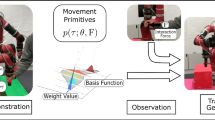Abstract
The creation of physical behavior by computational means has been approached differently by industrial and artificial intelligence robotics. Industrial robotics, considering fast response of a robot its most important characteristic, has equipped the robot with predefined, specific behavioral trajectories resulting in fast but inflexible behavior. Artificial intelligence robotics, claiming flexibility as the paramount robot feature, has employed inferred behavior whereby the robot itself determines behavioral patterns for tasks based on the robot's general knowledge about a task domain. Response is now flexible, but the response time is commonly badly degraded. This work defines an action propensity “skill” which generates flexibleand fast behavior. Flexibility is achieved by attaching “perceptions” in skills to guide behavior; fast response results from the direct activation of skills. The acquisition and generalization of skills happens under the supervision of a human teacher in an advice-taking mode into which the robot shifts from the execution mode after recognizing lacking competence for a given task. This paper defines such skills, describes an implemented skilled robot system, and discusses some simulation results.
Similar content being viewed by others
References
S. E. Fahlman, “A planning system for robot construction tasks,”Artif. Intell. 5:1–49 (1974).
R. E. Fikes, P. E. Hart, and N. I. Nilsson, “Learning and executing generalized robot plans,”Artif. Intell. 3:251–288 (1972).
C. J. Fillmore, “The case for case,” inUniversals in Linquistic Theory, E. Bach, and R. Harms, eds. (Holt, Rinehart, and Winston, 1968), pp. 1–88.
J. J. Gibson. “The theory of affordance,” tinPerceiving, Acting, and Knowing, R. Shaw, and I. Bransford, eds (Lawrence Erlbaum, 1977), pp. 67–82.
P. I. Hayes, “A representation for robot plans,”4th International Joint Conference on Artificial Intelligence (1975), pp. 181–188.
H. Jäppinen, “Heuristic programming—an emerging trend in the 80's,”Proceedings of NordDATA-80 Conference (1980), pp. 551–556.
H. Jäppinen, “An application of teaching to intelligent robot behavior,” Helsinki University of Technology, Digital Systems Laboratory, Report B9, (1980).
H. Jäppinen, “Intelligent behavior without planning,”The Fifth European Meeting on Cybernetics and Systems Research (1981).
J. Piaget and B. Inhelder,The Psychology of the Child (Basic Books, New York, 1969).
E. D. Sacerdoti,A Structure for Plans and Behavior (American Elsevier, New York, 1977).
E. D. Sacerdoti, “Planning in a hierarchy of abstraction spaces,”Artif. Intell. 5:115–135 (1974).
G. Sussman,A Computer Model of Skill Acquisition (American Elsevier, New York, 1975).
S. Tangwongsan and K. S. Fu, “An application of learning to robotic planning.”Int. J. Comput. Inform. Sci. 8(4):303–333 (1979).
Author information
Authors and Affiliations
Rights and permissions
About this article
Cite this article
Jäppinen, H. Sense-controlled flexible robot behavior. International Journal of Computer and Information Sciences 10, 105–125 (1981). https://doi.org/10.1007/BF00977744
Received:
Revised:
Issue Date:
DOI: https://doi.org/10.1007/BF00977744




